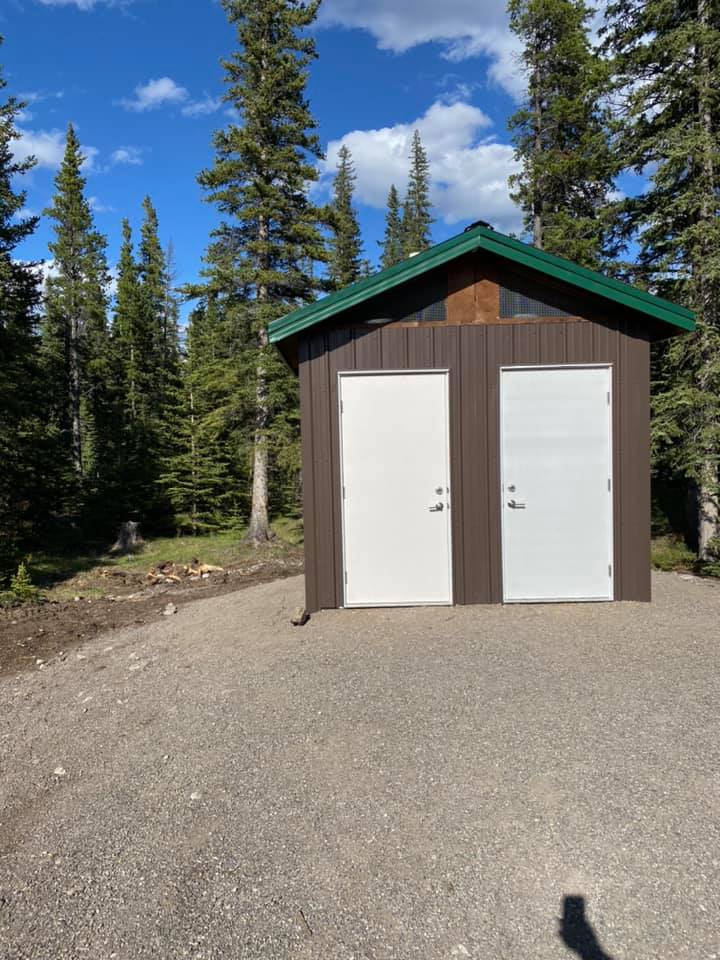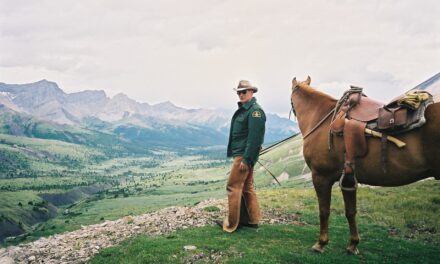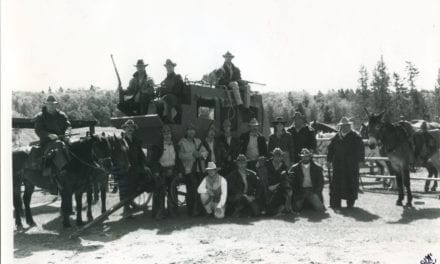Rod: Can you explain how your meetings progressed?
Clarence: Our first general meeting was held on February 5th, 1994 in Innisfail. There were 150 people in attendance. A society was formed with 14 on the Board of Directors. Leon Graham, from the Sundre Forestry Office, wanted to know what was going on. He contacted me and we met with him on February 16th, 1994. Alberta Environment personnel were Kelly O’Shea, who was Acting Forest Superintendent, Ted Flanders, Leon Graham and Kurt Wenzel. We discussed the plan of the Eagle Creek location. We stated our position that camping remain open at the Ya Ha Tinda and we requested that the Province work with Parks Canada towards a mutual objective to provide an acceptable solution to meet this request.
On March 15th, 1994 we had a meeting with the Superintendent of Forestry at Rocky Mountain House and another fellow by the name of George Robinson and we again asked for them to work with Parks Canada to keep the campground open. On March 19th, 1994 we went to our local MLA Ty Lund. We, Jack Holmes and I, took the petitions that 3376 people had signed. Mr. Lund was going to take the petitions to the legislature; however, our decision was to hold off until we see how our meeting(s) went with Parks Canada. So, we didn’t present these petitions to the legislature. On March 22nd, 1994 a special meeting was held with Parks Canada officials Doug Stewart and Percy Weibe and the Ya Ha Tinda Ranch Manager Ken Pigeon. Doug Stewart related the problems with the campground and that the intent was to work with the Forestry Service to establish a campground facility at Eagle Creek. We presented Parks Canada with our proposal. Parks Canada agreed to meet with a representative from Alberta Forestry and a representative of FOESA to come up with recommendations that may be suitable for all three parties.
Later on I obtained a copy of the Upper Red Deer Recreational Plan which included the development of a new facility at Eagle Creek campground. On April 20, 1994 the Upper Red Deer River Recreational Plan open house and public meeting was held. Of course, we objected to their plan because we did not want to move out of the Bighorn Campground.
Rod: Was Parks Canada present at that open house?
Clarence: No. That was Alberta Forest Service only.
On July 15, 1994 we had a meeting with Percy Weibe and Ken Pigeon from Parks Canada; and Ted Flanders from Alberta Lands and Forest Service, and our board of directors. Alberta Lands and Forest Service notified us that pit toilets were no longer permitted and requested our involvement in installing two fiberglass holding tanks for outhouses in the Bighorn Campground. There was an expense involved. During our lunch break our executive agreed that each of us would contribute $200 out of our own pockets. So we went back to this meeting and we said, “Okay guys, we are buying the new (toilet) tanks.” The club (FOESA) had about $800 at that time and the executive members personal contributions of about $1200 covered the cost. So that kind of sealed it at that point. So then, we discussed further what we were going to do. We purchased the tanks for $1942.00 and they were installed on August 15th, 1994 and they were operational for that weekend. So that kind of sealed it.

One of the new pump-out toilets installed by the Friends of the Eastern Slopes Association.
Marie: That showed some dedication on the part of FOESA.
Rod: Did you get help to install them?
Clarence: Alberta Forest Service had two outhouses that they weren’t using so they brought them down. The AFS employee who spearheaded the installation of our first outhouse tanks was Brian Godwin. He was just a working fool – and he worked us so hard that day putting those tanks in. Everything had to be just right…it had to be packed with sand …and this sort of thing…a great fellow he was. He supported us 100 percent and went with us to visit Ty Lund, Alberta Environment Minister at that time, and he also arranged our involvement with the Black Rock Lookout Tower improvements.
And that is basically how we started. That kind of sealed us getting in there.
Rod: That is a good summary of how those events unfolded.
Marie: Did you recoup your personal investment from the memberships and donations?
Clarence: At that time no.
Rod: In terms of a formal agreement with Parks did they come up with one?
Clarence: The Memorandum Of Understanding (MOU) was first talked about with Alberta Land and Forest Services, Parks Canada and the Friends of the Eastern Slopes. A MOU was drawn up by Doug Stewart, Director, Alberta South District, Department of Canadian Heritage. This agreement was then sent to Cliff Henderson, Director, Forest Management Division, Alberta Land and Forest Services for approval. We were under the impression that this was taken care of. But, as time went on we learned that the province did not like the agreement because they had concerns about horse manure in the creeks and this kind of stuff. My understanding is that Alberta refused to sign it. That would have been in June of 1994. So anyway, we thought that we had it for a while and then realized we didn’t. So, Perry Jacobson, Chief Warden of Kootenay Park, had taken on the management of the Ya Ha Tinda Ranch as part of his jurisdiction, as the ranch was considered backcountry. I stopped to consult with him a number of times.
Marie: I believe that Charlie Zinkan, who was Superintendent of Banff National Park, gave the portfolio of managing the Ya Ha Tinda Ranch to Perry Jacobson as Perry had a strong background in ranching and he had been a park warden in Banff for many years and had a good understanding of the operation of the ranch.
Clarence: And luckily, Perry got transferred back to Banff. (Perry Jacobson became Chief Park Warden of Banff National Park). So then the ranch (portfolio) was transferred back to Banff with Perry. In 2000 Perry Jacobson made up a new MOU between Parks Canada and the Friends of the Eastern Slopes. This was strictly between the two parties and it was for two years at a time. The last one I signed on behalf of FOESA was in 2012 when I was still on the board.
Dale: The latest MOU is for a five-year period. But it seems as if we do sign it almost annually.
Clarence: The first one that was signed states “This MOU will be in effect for a period of two years commencing on April 1/2000 with options for renewal after that date.” The MOU was signed by John Allard, A/Field Unit Superintendent, Banff National Park and Clarence Stewart, President, Friends of the Eastern Slopes Association.
Rod: Does it spell out both the requirements and the proportional responsibilities of both parties?
Clarence: I will give you a copy of both MOUs.
Dale: The more recent MOUs include clauses for things like the outhouses, berms etc.
Rod: So the more recent MOUs evolved due to more and more responsibilities for yourselves and not so much for Parks Canada?
Larry: I have a copy of the more recent MOUs and I can email a copy to Marie.
Marie: Thank you. That would be fine.
Rod: So, with these MOUs they are kind of a renewable agreement and unless there is some real problem you can assume that it will be renewed. Has there ever been a problem where renewal has been an issue?
Clarence: No. I always took care of it (as President) when it expired I just phoned Parks Canada and they would send out another one. I would sign it and send it back to them. They’d sign it and send a copy back to me.
Rod: Was there ever any discussion about a long-term agreement – longer than two years.
Clarence: Yes, actually, when we first started we asked for a 25-year lease.
Dale: I took over as President a few years after Clarence. (Bob Long became President of FOESA after Clarence Stewart and served for several years. Murray Hagel also served as President for a time but resigned part way through the 2011-12 year at which point Dale Marshall fulfilled the position of President for a few years. Larry Frischke is the current President.) We’ve been renewing the MOU at our annual banquet after first discussing the MOU prior to that date. We would sign it at that time and then it would go back to Banff and they’d send us a signed copy. It is about a 3-4 page document now.
Rod: But that hasn’t inhibited your activities at all?
Dale: No, not at all.
Larry: The agreement delineates the things like the berm, the waterway, the parameters of the campground etc.
Rod: That is encouraging from my perspective that they do that because as you know the warden service in particular has undergone tremendous change in the past ten years. And there has been a shift in parks’ priorities towards more of a ‘visitor enhancement’ or whatever the term is that they use now. There has also been an emphasis on more of a business-like operation. They are serious about revenue generation so to me it’s really encouraging that they haven’t pressed the issue.
Dale: There were quite a few years where we used to haul the manure out but then they wouldn’t let us do that as they were going to use some of it on the ranch, or whatever. We have walked that place a dozen times to make a decision on how to handle it and parks was to get back to us and it never happens. We did haul a whole pile of it out there this past winter but they want us to talk to them first before we do anything with it.
We have permission from the Province to haul it out to the pile (at Wild Horse Creek).




Recent Comments